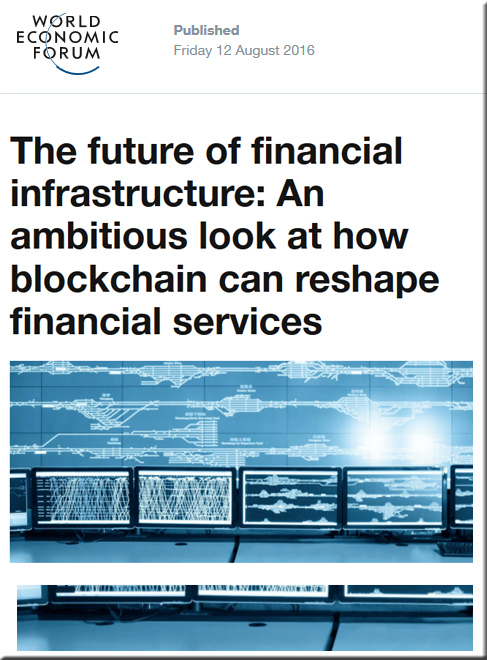From DSC:
A classroom of the future perhaps? These graphics depict VR-based chats/talk shows from @guntersuniverse
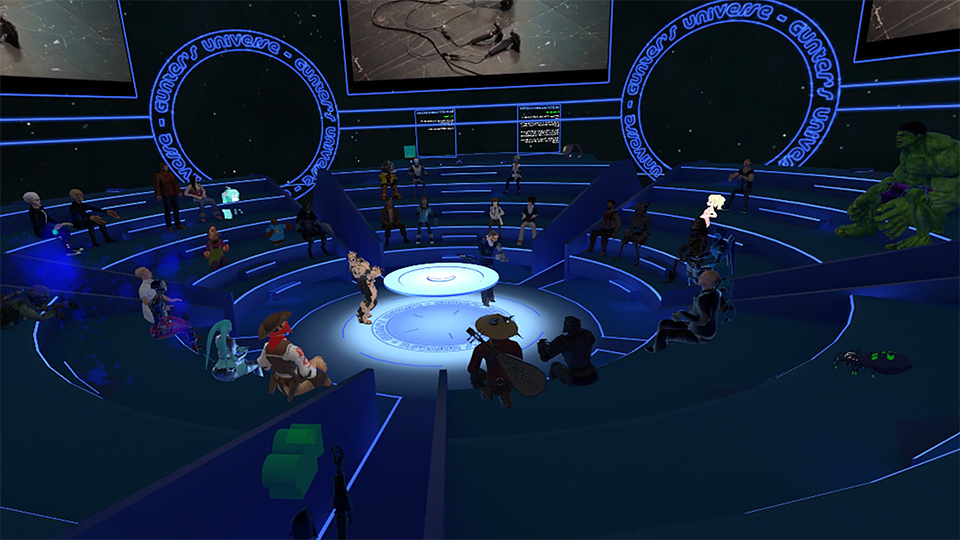
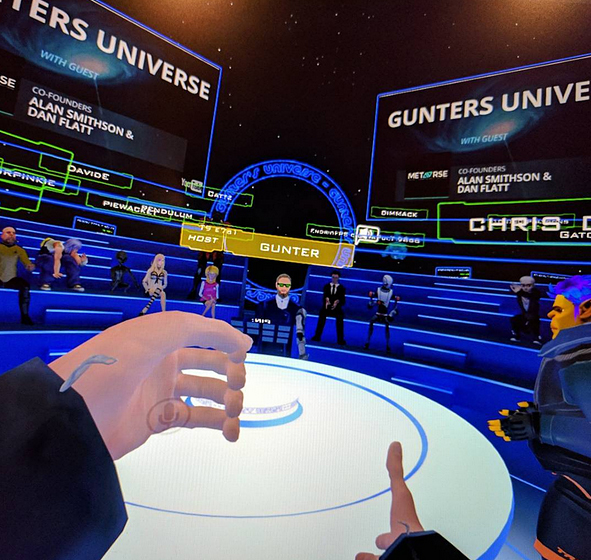
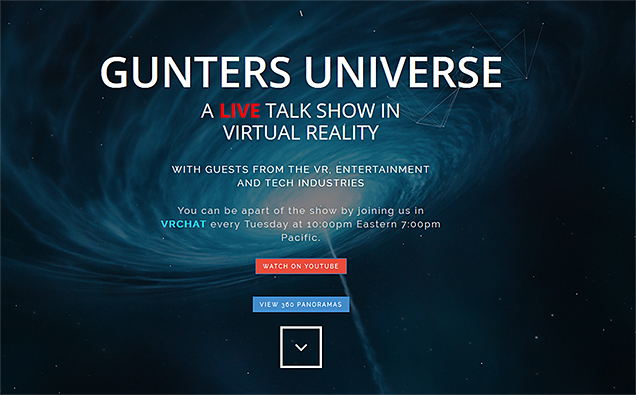




From DSC:
A classroom of the future perhaps? These graphics depict VR-based chats/talk shows from @guntersuniverse



Amazon introduces Echo Show
The description reads:
From DSC:
Now we’re seeing a major competition between the heavy-hitters to own one’s living room, kitchen, and more. Voice controlled artificial intelligence. But now, add the ability to show videos, text, graphics, and more. Play music. Control the lights and the thermostat. Communicate with others via hands-free video calls.
Hmmm….very interesting times indeed.
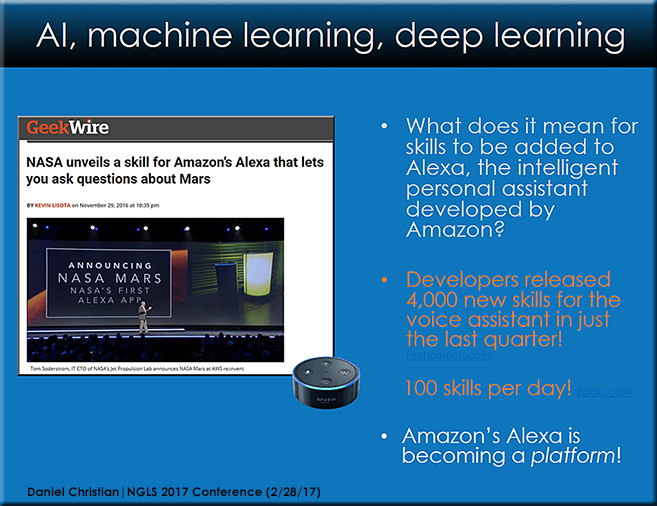
Developers and corporates released 4,000 new skills for the voice assistant in just the last quarter. (source)
…with the company adding about 100 skills per day. (source)
![The Living [Class] Room -- by Daniel Christian -- July 2012 -- a second device used in conjunction with a Smart/Connected TV](http://danielschristian.com/learning-ecosystems/wp-content/uploads/2012/07/The-Living-Class-Room-Daniel-S-Christian-July-2012.jpg)
Addendum on 5/10/17:
New Google Earth has exciting features for teachers — from thejournal.com by Richard Chang
Excerpt:
Google has recently released a brand new version of Google Earth for both Chrome and Android. This new version has come with a slew of nifty features teachers can use for educational purposes with students in class. Following is a quick overview of the most fascinating features…
The Blockchain Revolution and Higher Education — from er.educause.edu by Don Tapscott and Alex Tapscott
The blockchain provides a rich, secure, and transparent platform on which to create a global network for higher learning. This Internet of value can help to reinvent higher education in a way the Internet of information alone could not.
Excerpt:
What will be the most important technology to change higher education? In our view, it’s not big data, the social web, MOOCs, virtual reality, or even artificial intelligence. We see these as components of something new, all enabled and transformed by an emerging technology called the blockchain.
OK, it’s not the most sonorous word ever, sounding more like a college football strategy than a transformative technology. Yet, sonorous or not, the blockchain represents nothing less than the second generation of the Internet, and it holds the potential to disrupt money, business, government, and yes, higher education.
The opportunities for innovators in higher education fall into four categories:
The blockchain may help us change the relationships among colleges and universities and, in turn, their relationship to society.
Let us explain.
What if there was an Internet of value — a global, distributed, highly secure platform, ledger, or database where we could store and exchange things of value and where we could trust each other without powerful intermediaries? That is the blockchain.
From DSC:
The quote…
In 2006, MIT President Emeritus Vest offered a tantalizing vision of what he called the meta-university. In the open-access movement, he saw “a transcendent, accessible, empowering, dynamic, communally constructed framework of open materials and platforms on which much of higher education worldwide can be constructed or enhanced.”
…made me wonder if this is where a vision that I’m tracking called Learning from the Living [Class] Room is heading. Also, along these lines, futurist Thomas Frey believes
“I’ve been predicting that by 2030 the largest company on the internet is going to be an education-based company that we haven’t heard of yet,” Frey, the senior futurist at the DaVinci Institute think tank, tells Business Insider. (source)
Blockchain could be a key piece of this vision.
Apple Releases Education Bundle With Video, Audio Editing Tools — from campustechnology.com
Excerpt:
Apple Friday introduced its Pro Apps Bundle for Education, available for K–12 schools and higher ed institutions.
The bundle is a collection of five apps from Apple that deliver industry-level tools for video editors and musicians:
Also see:
From DSC:
Don’t discount the game-changing power of the morphing “TV” when coupled with artificial intelligence (AI), natural language processing (NLP), and blockchain-based technologies!
When I saw the article below, I couldn’t help but wonder what (we currently know of as) “TVs” will morph into and what functionalities they will be able to provide to us in the not-too-distant future…?
For example, the article mentions that Seiki, Westinghouse, and Element will be offering TVs that can not only access Alexa — a personal assistant from Amazon which uses artificial intelligence — but will also be able to provide access to over 7,000 apps and games via the Amazon Fire TV Store.

Some of the questions that come to my mind:
Forget a streaming stick: These 4K TVs come with Amazon Fire TV inside — from techradar.com by Nick Pino
Excerpt:
The TVs will not only have access to Alexa via a microphone-equipped remote but, more importantly, will have access to the over 7,000 apps and games available on the Amazon Fire TV Store – a huge boon considering that most of these Smart TVs usually include, at max, a few dozen apps.

![The Living [Class] Room -- by Daniel Christian -- July 2012 -- a second device used in conjunction with a Smart/Connected TV](http://danielschristian.com/learning-ecosystems/wp-content/uploads/2012/07/The-Living-Class-Room-Daniel-S-Christian-July-2012.jpg)
Addendums
“I’ve been predicting that by 2030 the largest company on the internet is going to be an education-based company that we haven’t heard of yet,” Frey, the senior futurist at the DaVinci Institute think tank, tells Business Insider.
.
The New Media Consortium (NMC) has released Digital Literacy: An NMC Horizon Project Strategic Brief in conjunction with the 2016 EDUCAUSE Annual Conference.
…
In analyzing the progress and gaps in this area, the NMC’s report has identified a need for higher education leaders and technology companies to prioritize students as makers, learning through the act of content creation rather than mere consumption. Additionally, the publication recommends that colleges and universities establish productive collaborations with industry, government, and libraries to provide students with access to the latest technologies and tools.
…
Based on the variety and complexity of these results, NMC cannot identify just one model of digital literacy. Instead three different digital literacies are now evident, each with distinct standards, potential curriculum, and implications for creative educators.
The aim of this publication is to establish a shared vision of digital literacy for higher education leaders by illuminating key definitions and models along with best practices and recommendations for implementing successful digital literacy initiatives.
To be digitally literate, you need to be:
fluent at critical thinking, collaborating,
being creative, and problem-solving in
digital environments.
Computer science and digital media classes can instruct on everything from office productivity applications to programming and video editing, for example. Sociology courses can teach interpersonal actions online, such as the ethics and politics of social network interaction, while psychology and business classes can focus on computer-mediated human interaction. Government and political science classes are clearly well equipped to explore the intersection of digital technology and citizenship mentioned above. Communication, writing, and literature classes have the capacity to instruct students on producing digital content in the form of stories, arguments, personal expression, posters, and more.
From DSC:
If faculty members aren’t asking students to create multimedia in their assignments and/or take part in online/digitally-based means of communications and learning, the vast majority of the students won’t (and don’t) care about digital literacy…it’s simply not relevant to them: “Whatever gets me the grade, that’s what I’ll do. But no more.”
This type of situation/perspective is quite costly. Because once students graduate from college, had they built up some solid digital literacy — especially the “creative literacy” mentioned above — they would be in much better shape to get solid jobs, and prosper at those jobs. They would be much better able to craft powerful communications — and reach a global audience in doing so. They would have honed their creativity, something increasingly important as the onward march of AI, robotics, algorithms, automation, and such continues to eat away at many types of jobs (that don’t really need creative people working in them).
This is an important topic, especially as digitally-based means of communication continue to grow in their usage and impact.
Part of digital literacy is not just understanding how a tool works but also why it is useful in the real world and when to use it.
10 Incredible Uses of Virtual Reality — from fortune.com by Rose Leadem
It’s not just for video games.
Excerpt:
Virtual reality technology holds enormous potential to change the future for a number of fields, from medicine, business, architecture to manufacturing.
Psychologists and other medical professionals are using VR to heighten traditional therapy methods and find effective solutions for treatments of PTSD, anxiety and social disorders. Doctors are employing VR to train medical students in surgery, treat patients’ pains and even help paraplegics regain body functions.
In business, a variety of industries are benefiting from VR. Carmakers are creating safer vehicles, architects are constructing stronger buildings and even travel agencies are using it to simplify vacation planning.
Check out these 10 amazing uses of VR.
Visit the U.K. Prime Minister’s Home in This Virtual 10 Downing Street Experience — from uploadvr.com by
Excerpt:
Google has unveiled a new interactive online exhibit that take users on a tour of 10 Downing street in London — home of the U.K. Prime Minister.
The building has served as home to countless British political leaders, from Winston Churchill and Margaret Thatcher through to Tony Blair and — as of a few months ago — Theresa May. But, as you’d expect in today’s security-conscious age, gaining access to the residence isn’t easy; the street itself is gated off from the public. This is why the 10 Downing Street exhibit may capture the imagination of politics aficionados and history buffs from around the world.
The tour features 360-degree views of the various rooms, punctuated by photos and audio and video clips.
Microsoft’s HoloLens Now Helps Elevator Technicians Work Smarter — from uploadvr.com by Charles Singletary
Excerpt:
In a slightly more grounded environment, the HoloLens is being used to assist technicians in elevator repairs.
Traversal via elevator is such a regular part of our lifestyles, its importance is rarely recognized…until they’re not working as they should be. ThyssenKrupp AG, one of the largest suppliers for elevators, recognizes how essential they are as well as how the simplest malfunctions can deter the lives of millions. Announced on their blog, Microsoft is partnering with Thyssenkrupp to equip 24,000 of their technicians with HoloLens.
Insert from DSC re: the above piece re: HoloLens:
Will technical communicators need to augment their skillsets? It appears so.
Phiona: A Virtual Reality Portrait of ‘Queen of Katwe’ — from abcnews.com by Angel Canales and Adam Rivera
Get a front-row seat in Harvard’s largest class, thanks to virtual reality — from medium.freecodecamp.com by Dhawal Shah
Intro video here: This is CS50 2016
The future of mobile video is virtual reality — from techcrunch.com by Mike Wadhera
Excerpt:
But in a world where no moment is too small to record with a mobile sensor, and one in which time spent in virtual reality keeps going up, interesting parallels start to emerge with our smartphones and headsets.
Let’s look at how the future could play out in the real world by observing three key drivers: VR video adoption, mobile-video user needs and the smartphone camera rising tide.
Now, a virtual reality programme to improve social skills in autistic kids — from cio.economictimes.indiatimes.com by
The VR training platform creates a safe place for participants to practice social situations without the intense fear of consequence.
Excerpt:
“Individuals with autism may become overwhelmed and anxious in social situations,” research clinician Dr Nyaz Didehbani said.
“The virtual reality training platform creates a safe place for participants to practice social situations without the intense fear of consequence,” said Didehbani.
The participants who completed the training demonstrated improved social cognition skills and reported better relationships, researchers said.
Also see:
LinkedIn announced several things yesterday (9/22/16). Below are some links to these announcements:
Introducing LinkedIn Learning, a Better Way to Develop Skills and Talent — from learning.linkedin.com
Excerpt (emphasis DSC):
Today, we are thrilled to announce the launch of LinkedIn Learning, an online learning platform enabling individuals and organizations to achieve their objectives and aspirations. Our goal is to help people discover and develop the skills they need through a personalized, data-driven learning experience.
LinkedIn Learning combines the industry-leading content from Lynda.com with LinkedIn’s professional data and network. With more than 450 million member profiles and billions of engagements, we have a unique view of how jobs, industries, organizations and skills evolve over time. From this, we can identify the skills you need and deliver expert-led courses to help you obtain those skills. We’re taking the guesswork out of learning.
The pressure on individuals and organizations to adapt to change has never been greater. The skills that got you to where you are today are not the skills to prepare you for tomorrow. In fact, the shelf-life of skills is less than five years, and many of today’s fastest growing job categories didn’t even exist five years ago.
To tackle these challenges, LinkedIn Learning is built on three core pillars:
…
Data-driven personalization: We get the right course in front of you at the right time. Using the intelligence that comes with our network, LinkedIn Learning creates personalized recommendations, so learners can efficiently discover which courses are most relevant to their goals or job function. Organizations can use LinkedIn insights to customize multi-course Learning Paths to meet their specific needs. We also provide robust analytics and reporting to help you measure learning effectiveness.
LinkedIn’s first big move since the $26.2 billion Microsoft acquisition is basically a ‘school’ for getting a better job — from finance.yahoo.com
Excerpt:
Today, LinkedIn has launched LinkedIn Learning — its first major product launch since the news last June that Microsoft would be snapping up the social network for $26.2 billion in a deal that has yet to close.
LinkedIn Learning takes the online skills training classes the company got in its 2015 acquisition of Lynda.com for $1.5 billion.
The idea, says LinkedIn CEO Jeff Weiner, is to help its 433 million-plus members get the skills they need to stay relevant in a world that’s increasingly reliant on digital skills.
LinkedIn’s New Learning Platform to Recommend Lynda Courses for Professionals — from edsurge.com by Marguerite McNeal
Excerpt:
Companies will also be able to create their own “learning paths”—bundles of courses around a particular topic—to train employees. A chief learning officer, for instance, might compile a package of courses in product management and ask 10 employees to complete the assignments over the course of a few months.
…
LinkedIn is also targeting higher-education institutions with the new offering. It is marketing the solution as a professional development tool that can help faculty learn how to use classroom tools such as Moodle, Adobe Captivate and learning management systems.
“Increasingly predictions of tech displacing workers are coming to fruition,” he added. “The idea that you can study a skill once and have a job for the rest of your life—those days are over.”
LinkedIn Learning for higher education
Accelerating LinkedIn’s Vision Through Innovation — from slideshare.net
LinkedIn adding new training features, news feeds and ‘bots’ — from finance.yahoo.com
Excerpt:
LinkedIn is also adding more personalized features to its news feed, where members can see articles and announcements posted by their professional contacts. A new “Interest Feed” will offer a collection of articles, posts and opinion pieces on major news events or current issues.
The future of financial infrastructure: An ambitious look at how blockchain can reshape financial services — from weforum.org
Key findings include:
The report is centered on use cases, considering how distributed ledger technology could benefit each scenario. How will blockchain transform the future of financial services?
Ernst & Young’s report anticipates blockchain to reach critical mass in 3-5 years — from coinspeaker.com by Tatsiana Yablonskaya
Ernst and Young explains that financial industry is far from being the only one that can benefit from the blockchain technology.
Excerpt (emphasis DSC):
Ernst & Young, leading consulting firm, one of the “Big Four” audit firms and the third largest professional services firm in the world, has made some predictions about the future of the blockchain technology and its significance in various industry sectors in the recent report.
The attention of multiple financial companies has been focused on the blockchain lately. This unique technology is well adaptable to the increasing requirements of secure bookkeeping and automation in various industries.
The EY report predicts that blockchain will reach critical mass in financial services in 3-5 years, with other industries following quickly. “One reason the blockchain reaction is racing toward critical mass faster than previous disruptive technologies is that it is arriving in the midst of the digital transformation already sweeping through most sectors of the global economy. Consequently, despite the obstacles still to be overcome, businesspeople and governments are preconditioned to recognize blockchain’s potential. Tech companies have already established much of the digital infrastructure required to realize blockchain business visions.”
From DSC:
Applying this technology towards the world of learning…
I wonder how blockchain might impact credentialing for lifelong learning, and will it be integrated into services available via tvOS-based applications? This type of cloud-based offering/service could likely be a piece of our future learning ecosystems. Innovative, forward-thinking institutions should put this on their radar now, and start working on such efforts.
This is why I’m so excited about the “The Living [Class] Room” vision. Because it is through that vision that people of all ages — and from all over the world — will be able to constantly learn, grow, and reinvent themselves (if need be) throughout their lifetimes. They’ll be able to access and share content, communicate and discuss/debate with one another, form communities of practice, go through digital learning playlists (like Lynda.com’s Learning Paths) and more. All from devices that represent the convergence of the television, the telephone, and the computer (and likely converging with the types of devices that are only now coming into view, such as Microsoft’s Hololens).
You won’t just be limited to going back to college for a day — you’ll be able to do that 24×7 for as many days of the year as you want to.
Then when some sophisticated technologies are integrated into this type of platform — such as artificial intelligence, cloud-based learner profiles, algorithms, and the ability to setup exchanges for learning materials — we’ll get some things that will blow our minds in the not too distant future! Heutagogy on steroids!
Want to go back to college? You can, for a day. — from washingtonpost.com by Valerie Strauss
Excerpt:
Have you ever thought about how nice it would be if you could go back to college, just for the sake of learning something new, in a field you don’t know much about, with no tests, homework or studying to worry about? And you won’t need to take the SAT or the ACT to be accepted? You can, at least for a day, with something called One Day University, the brainchild of a man named Steve Schragis, who about a decade ago brought his daughter to Bard College as a freshman and thought that he wanted to stay.
One Day University now financially partners with dozens of newspapers — including The Washington Post — and a few other organizations to bring lectures to people around the country. The vast majority of the attendees are over the age 50 and interested in continuing education, and One Day University offers them only those professors identified by college students as fascinating. As Schragis says, it doesn’t matter if you are famous; you have to be a great teacher. For example, Schragis says that since Bill Gates has never shown to be one, he can’t teach at One Day University.
…
We bring together these professors, usually four at at a time, to cities across the country to create “The Perfect Day of College.” Of course we leave out the homework, exams, and studying! Best if there’s real variety, both male and female profs, four different schools, four different subjects, four different styles, etc. There’s no one single way to be a great professor. We like to show multiple ways to our students.
Most popular classes are history, psychology, music, politics, and film. Least favorite are math and science.
See also:
Addendum:
We know the shelf-life of skills are getting shorter and shorter. So whether it’s to brush up on new skills or it’s to stay on top of evolving ones, Lynda.com can help you stay ahead of the latest technologies.
Apple TV: Apple Unveils New “Live Tune-In” Feature With Latest tvOS Update — from idigitaltimes.com by Michael Gardiner
Excerpt (excerpt):
If you happen to have a fourth generation Apple TV, then there’s some good news: Apple’s “Live Tune-In” feature is officially live. This feature allows an Apple TV user to ask Siri to automatically transport them to the livestream of a tvOS app from the home screen, an idea that could go a long way in making the Apple TV’s app navigation less painful.
From DSC:
What if these live streams were live lectures?
From DSC:
Let’s take some of the same powerful concepts (as mentioned below) into the living room; then let’s talk about learning-related applications.
Google alum launches MightyTV for cable cord-cutters — from bizjournals.com by Anthony Noto
Excerpts (emphasis DSC):
MightyTV, which has raised more than $2 million in venture funding to date, launched today with a former Google exec at the helm. The startup’s technology incorporates machine learning with computer-generated recommendations in what is being touted as a “major step up” from other static list-making apps.
…
In this age of Roku and Apple TV, viewers can choose what to watch via the apps they’ve downloaded. MightyTV curates those programs — shows, movies and YouTube videos — into one app without constantly switching between Amazon, HBO, Netflix or Hulu.
…
Among the features included on MightyTV are:
* A Tinder-like interface that allows users to swipe through content, allowing the service to learn what you’d like to watch
* An organizer tool that lists content via price range
* A discovery tool to see what friends are watching
* Allows for group viewings and binge watching
From DSC:
What if your Apple TV could provide these sorts of functionalities for services and applications that are meant for K-12 education, higher education, and/or corporate training and development?
Instead of Amazon, HBO, Netflix or Hulu — what if the interface would present you with a series of learning modules, MOOCs, and/or courses from colleges and universities that had strong programs in the area(s) that you wanted to learn about?
That is, what if a tvOS-based system could learn more about you and what you are trying to learn about? It could draw upon IBM Watson-like functionality to provide you with a constantly morphing, up-to-date recommendation list of modules that you should look at. Think microlearning. Reinventing oneself. Responding to the exponential pace of change. Pursuing one’s passions. More choice/more control. Lifelong learning. Staying relevant. Surviving.
…all from a convenient, accessible room in your home…your living room.
A cloud-based marketplace…matching learners with providers.
Now tie those concepts in with where LinkedIn.com and Lynda.com are going and how people will get jobs in the future.
![The Living [Class] Room -- by Daniel Christian -- July 2012 -- a second device used in conjunction with a Smart/Connected TV](http://danielschristian.com/learning-ecosystems/wp-content/uploads/2012/07/The-Living-Class-Room-Daniel-S-Christian-July-2012.jpg)
BlueJeans Unveils Enterprise Video Cloud as Businesses Hang Up on Audio-Only Communications
Global Enterprises Adopt Video as a First-Line Communications Strategy
Excerpt (emphasis DSC):
April 12, 2016 — Mountain View, CA—BlueJeans Network, the global leader in cloud-based video communication services, today unveiled the Enterprise Video Cloud, a comprehensive platform built for today’s globally distributed, modern workforce with video communications at the core. New global research shows that 85% of employees are already using video in the workplace and 72% believe that video will transform the way they communicate at work.
“There is a transformation happening among business today – face-to-face video is quickly rising as the preferred communications medium, offering new opportunities for deeper personal relations and outreach, as well as for improved internal and external collaboration,” said Krish Ramakrishnan, CEO of BlueJeans. “Once people experience the power of video, they ‘hang-up’ on traditional conference calling. We are seeing this happen with the emergence of video cultures that power the most innovative cultures—from Facebook and Netflix to Viacom and Del Monte.”
From DSC:
I wonder if we’ll see video communication vendors such as BlueJeans or The Video Call Center merge with vendors like Bluescape, Mezzanine, or T1V with their collaboration tools. If so, some serious collaboration could all happen…again, right from within your living room!
What Gen Z thinks about ed tech in college — from edtechmagazine.com by D. Frank Smith
A report on digital natives sheds light on their learning preferences.
Excerpt (emphasis DSC):
A survey of the collegiate educational-technology expectations of 1,300 middle and high school students from 49 states was captured by Barnes and Noble. The survey, Getting to Know Gen Z, includes feedback on the students’ expectations for higher education.
“These initial insights are a springboard for colleges and universities to begin understanding the mindset of Gen Z as they prepare for their future, focusing specifically on their aspirations, college expectations and use of educational technology for their academic journey ahead,” states the survey’s introduction.
Like the millennials before them, Generation Z grew up as digital natives, with devices a fixture in the learning experience. According to the survey results, these students want “engaging, interactive learning experiences” and want to be “empowered to make their own decisions.” In addition, the students “expect technology to play an instrumental role in their educational experience.”
From DSC:
First of all, I’d like to thank D. Frank Smith for the solid article and for addressing the topic of students’ expectations. These messages were echoed in what I heard a few days ago at the MVU Online Learning Symposium, a conference focused on the K-12 space.

I want to quote and elaborate on one of the items from the report (as mentioned in the article):
“There is a need for user-friendly tools that empower faculty to design the kinds of compelling resources that will comprise the next wave of instructional resources and materials,” the report states.
Most likely, even if such tools were developed, the end goal from the quote above won’t happen. Why? Because:
This is why I continue to assert that we need a much more team-based approach to creating our learning environments. The problem is, very few people are listening to this advice.
How can I say this?
Because I continue to hear people discussing how important professional development is and how much support is needed for faculty members. I continue to see quotes, like the above one, that puts the onus solely on the backs of our faculty members. Conferences are packed full with this type of approach.
Let’s get rid of that approach — it’s not working! Or at least not nearly to the degree that students need it to. There may be a small percentage of faculty members who have the time and skills to pull some things off here, but even they will run into some walls eventually (depending upon the level of sophistication being pursued). None of us can do it all.
But for the most part, years have gone by and not much has changed. Rather, we need to figure out how we could use teams to create and deliver content. That would be a much wiser use of our energies and time. This perspective is not meant to dog faculty members — it’s just recognizing realities:
If we’re going to insist on faculty members creating the next wave of instructional materials and resources, then faculty members better look out — they don’t know what’s about to hit them. Forget about having families. Forget about having a life outside of creating/delivering content. And find a way to create a 50-60 hour work DAY (not week) — cause that’s how much time one will need to achieve any where’s close to mastery in all the prerequisite areas.
Start your journey: Lynda.com introduces Learning Paths to help you stay ahead — from linkedin.com
Excerpt:
We all know that the knowledge and skills required to be successful in our jobs today is accelerating. This rate of change challenges all of us to stay ahead in our roles and sets a high bar for those looking to start or change their careers. Today we are introducing more than 50 new learning paths to help you stay ahead in your current job or if you’re looking to make a career pivot.
Learning paths are step-by-step structured courses, supported with quizzes, practice, and learning reminders to encourage you and support you as you make progress towards your goal. These new learning paths include how to become a Web Developer, a Manager, a Bookkeeper, a Project Manager, a Small Business Owner, a Digital Marketer, a Digital Illustrator. Check out the full list here.
Learning paths are also a great way to continue expanding on your existing skill set. If you’re embarking on a new career, you can take advantage of these learning paths to become more knowledgeable about the skills and experience needed to secure your dream job. If you’re a marketing manager who needs to quickly get up to speed on how to leverage social media for your job, you could take the digital marketing learning path to continue grooming and adding new skills.
We know that making the commitment to learn is incredibly tough; sticking with it can be even harder. To ensure your hard work gets noticed, you’ll receive a certification of completion at the end of a learning path that you can share with your professional network on LinkedIn. Whether you’re looking to transform your current career path, jump into a new career, or sharpen your skills in your current job, Lynda.com can be your guide.
These new learning paths will be available starting today in English around the world and we are working towards adding new paths for you to take. We look forward to hearing about your learning path stories.
Also see:
LinkedIn launches Lynda.com ‘Learning Paths’ in push to grow education business — from forbes.com by Kathleen Chaykowski
Excerpt:
On Thursday, the Mountain View, Calif.-based company launched more than 50 Lynda.com “Learning Paths,” a package of ordered courses intended to prepare users for a specific role or to update users’ skills for their current job. Some of the new “Learning Paths” include how to become a digital marketer, photographer, digital illustrator, small business owner, project manager, bookkeeper or web developer.
“Whether you’re looking to transform your current career path, jump into a new career, or sharpen your skills in your current job, Lynda.com can be your guide,” Arthur Nicholls, a senior product manager at LinkedIn said. ”We all know that the knowledge and skills required to be successful in our jobs today is accelerating. This rate of change challenges all of us to stay ahead in our roles and sets a high bar for those looking to start or change their careers.”
Fuller profiles on candidates’ skills and qualifications will also advance LinkedIn’s efforts in building an economic graph, a digital map of the skills, economic needs, jobs, companies and people around the world.
